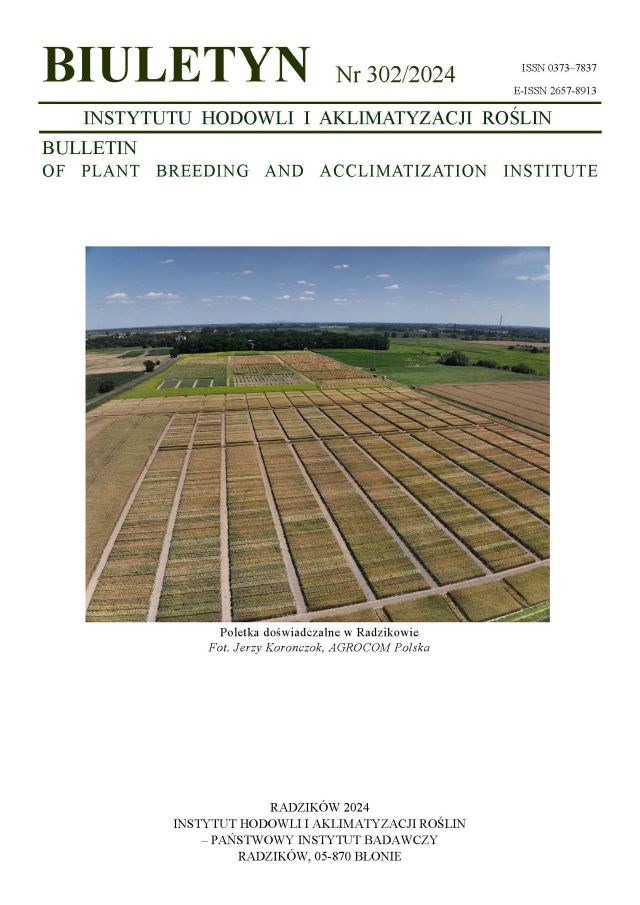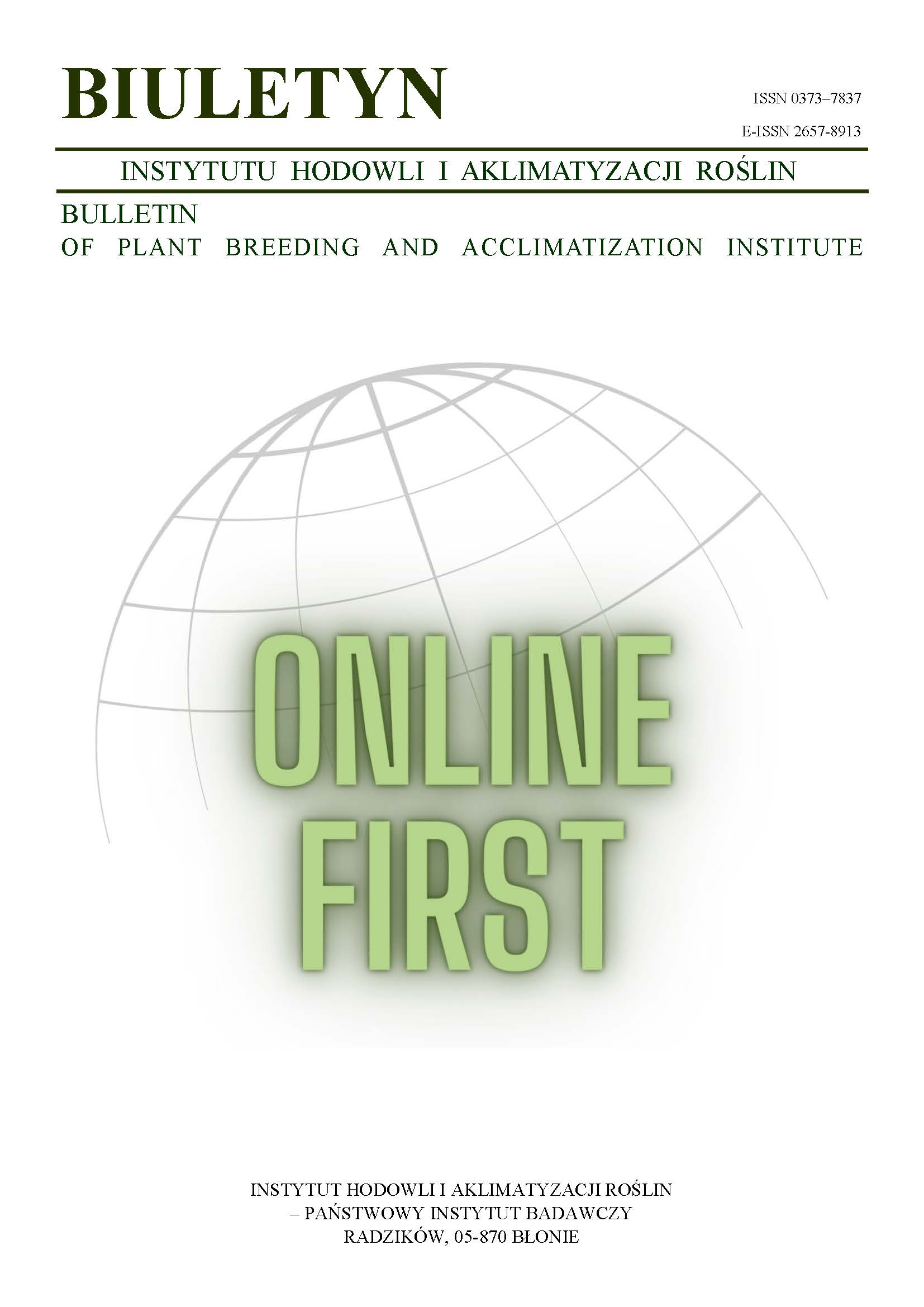The effect of natural and simulated drought on selected turf grass varieties
Grzegorz Żurek
g.zurek@ihar.edu.plInstytut Hodowli i Aklimatyzacji Roślin, Ogród Botaniczny, Bydgoszcz (Poland)
Abstract
During periods of natural drought in summer 1999 and spring 2000 5 varieties and 4 breeding lines of 6 turf grass species were evaluated in conditions of close and frequent mowing, no additional watering and low fertilization. Using 1–9 scale the condition of turf plots were evaluated during drought and subsequent regeneration. For the same objects, germination in negative water potential was also evaluated. A relationship was stated between germination in negative water potential and condition of turf plots during natural drought for some tested objects. Species ranked high after natural drought (Lolium perenne and Festuca arundinacea) germinated even at w = -2.05 MPa, but other species and varieties, ranked lower after drought, germinated only at w = 0.0 (control) and -0.65 MPa. High correlation was found between mean germination time at -0.65 MPa and turf plots condition during drying and post-drought regeneration. The above results suggest necessity for improving screening test on the basis of seed germination in low water potential.
Keywords:
PEG, Deschampsia cespitosa, Festuca arundinacea, Festuca rubra, Festuca ovina, Lolium perenne, Poa pratensis, drought, germination, turfReferences
Amin M. R., Thomas H. 1996. Growth and water relations of diverse populations of Lolium perenne exposed to drought in field, glasshouse and controlled environment. J. Agric. Science, Cambridge, 126: 15 — 23.
DOI: https://doi.org/10.1017/S0021859600088778
Google Scholar
Beard J. B. 1989. Turfgrass water stress: drought resistance components, physiological mechanisms and species — genotype diversity. Proc. of the 6th Int. Turfgrass Res. Conf. Tokyo, July 31 — August 5: 23 — 28.
Google Scholar
Brevedan R. E., Klich M.G., Sanchez E.E., Fioretti M.N. 1997. Effects of water stress on germination and seedling growth of love grass species. Proc. of the XVIII Int. Grassland Conference, June 8–17, 1997, Winnipeg & Saskatoon, Canada, 7: 35 — 36.
Google Scholar
Burton P. J., Bazzaz F.A. 1991. Tree seedling emergence on interactive temperature and moisture gradients and in patches of old field vegetation. Amer. J. Bot. 78 (1): 131 — 149.
DOI: https://doi.org/10.1002/j.1537-2197.1991.tb12579.x
Google Scholar
Carrow R. N. 1996 a. Drought avoidance characteristics of diverse tall fescue cultivars. Crop. Sci. 36: 371 — 377.
DOI: https://doi.org/10.2135/cropsci1996.0011183X003600020026x
Google Scholar
Carrow R. N. 1996 b. Drought resistance aspects of turfgrasses in the Southeast: root-shoot responses. Crop Sci. 36: 687 — 694.
DOI: https://doi.org/10.2135/cropsci1996.0011183X003600030028x
Google Scholar
Carrow R. N., Duncan R. R. 2003. Improving drought resistance and persistence in turf-type tall fescue. Crop.Sci. 43: 978 — 984.
DOI: https://doi.org/10.2135/cropsci2003.9780
Google Scholar
Cathey M. 2002. Water right. Conserving our water, preserving our environment. ITPF Water Right Book. (www.turfgrasssod.org/contents.htm).
Google Scholar
Dernoeden P. H., Carroll M. J., Krouse M. J. 1994. Mowing of three fescue species for low-maintenance turf sites. Crop Sci. 34, 6: 1645 — 1649.
DOI: https://doi.org/10.2135/cropsci1994.0011183X003400060041x
Google Scholar
Dernoeden P. H., Fidanza M. A., Krouse J. M. 1998. Low maintenance performance of five Fescue species in monostands and mixtures. Crop Sci. 38, 2: 434 — 438.
DOI: https://doi.org/10.2135/cropsci1998.0011183X003800020027x
Google Scholar
Diesburg K. L., Christians N. E., Moore R., B. T .K. Branham, Z. J. Danneberger, Reicher T., Voigt D., Minner D. Newman R. 1997. Species for low-input sustainable turf in the U.S. Upper Midwest. Agron. J. vol. 89, no. 4; 690 — 694.
DOI: https://doi.org/10.2134/agronj1997.00021962008900040024x
Google Scholar
Dodd G. L., Donovan L. A. 1999. Water potential and ionic effects on germination and seedling growth of two cold desert shrubs. Am. J. Bot. 86 (8): 1146 — 1153.
DOI: https://doi.org/10.2307/2656978
Google Scholar
Dorywalski J., Wojciechowicz M., Bartz J. 1964. Metodyka oceny nasion. PWRiL, Warszawa: 342 ss.
Google Scholar
Ellis R. H., Roberts E. H. 1978. Towards a rational basis or testing seed quality. In: Seed Production. P. D. Hebblethwaite (ed.), Butterworth, London: 606 — 636.
Google Scholar
Emmerich W. E., Hardegree S. P. 1990. Polyethylene glycol solution contact effects on seed germination. Agron. J. 82: 1103 — 1107.
DOI: https://doi.org/10.2134/agronj1990.00021962008200060015x
Google Scholar
Emmerich W. E., Hardegree S. P. 1991. Seed germination in polyethylene glycol solution: effects of filter paper exclusion and water vapor loss. Crop Sci. 31: 454 — 458.
DOI: https://doi.org/10.2135/cropsci1991.0011183X003100020046x
Google Scholar
Emmerich W. E., Hardegree S. P. 1996. Partial and full dehydration impact on germination of 4 warm — season grasses. J. Range Manage. 49 (4): 355 — 360.
DOI: https://doi.org/10.2307/4002597
Google Scholar
Falkowski M. 1982. Trawy polskie. Praca zbiorowa. PWRiL, Warszawa: 204 ss.
Google Scholar
Gallion J. 2003. Alternative to traditional lawn. The Master Gardeners (http://www.emmitsburg.net/ gardens/articles/frederick/2003/alternative_to_traditional_lawns.html).
Google Scholar
Grzesiak S., Filek W., Skrudlik G., Nizioł B. 1996. Screening for drought tolerance: evaluation of seed germination and seedling growth for drought resistance in legume plants. J. Agron. Crop Sci. 177, 4: 245 — 252.
DOI: https://doi.org/10.1111/j.1439-037X.1996.tb00242.x
Google Scholar
Grzesiuk S., Kulka K. 1981. Fizjologia i biochemia nasion. PWRiL, Warszawa: 605 ss.
Google Scholar
Hardegree S. P., Emmerich W. E. 1989. Effect of polyethylene glycol exclusion on the water potential of solution-saturated filter paper. Plant Physiol. 92: 462 — 466.
DOI: https://doi.org/10.1104/pp.92.2.462
Google Scholar
Hardegree S. P., Emmerich W. E. 1992. Seed germination response of four southwestern range grasses to equilibration at subgermination matric-potentials. Agron. J. 84: 994 — 998.
DOI: https://doi.org/10.2134/agronj1992.00021962008400060017x
Google Scholar
Harkot W., Czarnecki Z. 1999. Przydatność polskich odmian traw gazonowych do zadarniania powierzchni w trudnych warunkach glebowych. Fol. Univ. Agric. Stetin. 197 Agricultura (75): 117 — 120.
Google Scholar
Heydecker W. 1972. Vigour. In: Viability of seeds. Roberts E. H. (ed.), Chapman and Hall Ltd., London: 209 — 252.
DOI: https://doi.org/10.1007/978-94-009-5685-8_8
Google Scholar
Huang B., Duncan R. R., Carrow R. N. 1997. Drought — resistance mechanisms of seven warm-season turfgrasses under surface soil drying: II. Root aspects. Crop Sci. 37: 1863 — 1869.
DOI: https://doi.org/10.2135/cropsci1997.0011183X003700060033x
Google Scholar
Hull R. J. 1997. Managing turf for minimum water use. TurfNews, vol. 21, no. 2: 24 — 28.
Google Scholar
Humphreys M.W., H. Thomas. 1993. Improved drought resistance in introgression lines derived from Lolium multiflorum x Festuca arundinacea hybrids. Plant Breeding 111: 155 — 161.
DOI: https://doi.org/10.1111/j.1439-0523.1993.tb00622.x
Google Scholar
Johnson D. A., Asay K. H. 1978. A technique for assessing seedling emergence under drought stress. Crop Sci. 18: 520 — 522.
DOI: https://doi.org/10.2135/cropsci1978.0011183X001800030049x
Google Scholar
Kaufmann M. R., Ross K. J. 1970. Water potential, temperature, and kinetin effects on seed germination in soil and solute systems. Amer. J. Bot. 57 (4): 413 — 419.
DOI: https://doi.org/10.1002/j.1537-2197.1970.tb09831.x
Google Scholar
Kenna M. P., Horst G. L. 1993. Turfgrass water conservation and quality. Int. Turfgrass Society Res. Journ. 7. Carrow R. N., Christians N. E., Shearman R. C. (eds.) Intertec Publish. Corp. Overland Park, Kansas, US: 99 — 113.
Google Scholar
Krebb K. 1979. Ekofizjologia roślin. PWN, Warszawa: 213 ss.
Google Scholar
Loos M.T. 2003. Drought resistance in your home landscape. Ohio State University Extension Fact Sheet (http://ohioline.osu.edu/hyg-fact/1000/1643.html).
Google Scholar
Lutyńska R. 1993. Prace hodowlane i badania nad gatunkami traw z rodzaju Festuca. Biul. IHAR 188: 5 — 12.
Google Scholar
Marcum K. B., Still D. W., Maricic A. A. 2003. Determining drought tolerance of new bermudagrass cultivars at the germination stage. http://ag.arizona.edu/turf/germ.html.
Google Scholar
Minner D. D., Butler J. D. 1985. Drought tolerance of cool season turfgrasses. Proc. of the Fifth Int. Turfgrass Res. Conference, Avignon, France:198 — 212.
Google Scholar
Mintenko A. S., Smith S.R., Cattani D. J. 2002. Turfgrass evaluation of native grasses for the Northern Great Plains Region. Crop Sci. 42: 2018 — 2024.
DOI: https://doi.org/10.2135/cropsci2002.2018
Google Scholar
Petrovic A. M. 1995. Water conservation techniques in turfgrass. CUTT, Cornell University Turfgrass Times. vol. 6, no. 2: 1 — 6
Google Scholar
Prończuk M., Prończuk M., Laudański Z., Prończuk S. 2003. Porównanie gatunków i odmian Festuca spp. w wieloletnim użytkowaniu trawnikowym. Biul. IHAR, 225: 239 — 257.
Google Scholar
Prończuk S. 1993. System oceny traw gazonowych. Biul. IHAR 186: 127 —132.
Google Scholar
Prończuk S., Prończuk M, Żyłka D. 1997. Metody syntetycznej oceny wartości użytkowej traw gazonowych. Probl. Post. Nauk Roln., z. 451: 125 — 133.
Google Scholar
Prończuk S., Żurek G., Żyłka D., Prończuk M. 2001. Ocena śmiałka darniowego (Deschampsia cespitosa (L.) P.B.) w różnym użytkowaniu trawnikowym. Zesz. Probl. Post. Nauk Rol. zesz. 474: 113 — 122.
Google Scholar
Sharma M. L. 1973. Simulation of drought and its effect on germination of five pasture species. Agron. J. vol. 65, no. 6: 982 — 987.
DOI: https://doi.org/10.2134/agronj1973.00021962006500060041x
Google Scholar
Shinozaki K., K. Yamaguchi-Shinozaki. 1996. Molecular responses to drought and cold stress. Current Opinion i Biotechnology, 7: 161 — 167.
DOI: https://doi.org/10.1016/S0958-1669(96)80007-3
Google Scholar
Thomas H. 1990. Osmotic adjustment in Lolium perenne; its heritability and the nature of solute accumulation. Ann. Bot. 66: 521 — 530.
DOI: https://doi.org/10.1093/oxfordjournals.aob.a088061
Google Scholar
Thomas H. 1994. Diversity between and within temperate forage grass species in drought resistance, water use and related physiological responses. Aspects of App. Biol. Efficiency of water use in crop systems. 38: 47 —55.
Google Scholar
Thomas H., C. Evans. 1989. Effect of divergent selection for osmotic adjustment on water relations and growth of plants of Lolium perenne. Ann. of Bot. 64: 581 — 587.
DOI: https://doi.org/10.1093/oxfordjournals.aob.a087879
Google Scholar
Thomas H., Humphreys M., Howarth C., Bettany A. 1997. Plants for all seasons. IGER Innovations: 6 — 8.
Google Scholar
Thomas H., S. J. Dalton S. J., Evans C., Chorlton K. H., Thomas I. D. 1996. Evaluating drought resistance in germplasm of meadow fescue. Euphytica 92: 401 — 411.
DOI: https://doi.org/10.1007/BF00037125
Google Scholar
Wood G. M., Buckland H. E. 1966. Survival of turfgrass seedlings subjected to induced drought stress. Agron. J. vol. 58, no.1: 19 — 23.
DOI: https://doi.org/10.2134/agronj1966.00021962005800010007x
Google Scholar
Zajic M. J. 2003. Drought resistant gardens for National Capital area. Montgomery County, Park & Planning, Brookside Gardens (www.mcmncppc.org/parks/brookisde/drought.shtm).
Google Scholar
Żurek G. 2000 a. Strzęplice (Koeleria sp.) — mało znane gatunki do zadarniania terenów suchych. Cz. II. Ocena przydatności trawnikowej. Łąkarstwo w Polsce 3: 185—192.
Google Scholar
Żurek G. 2000 b. Effect of summer drought in 1999 on turf grass species. Plant Breed. Seed Sci. 44 (1): 73 — 83.
Google Scholar
Authors
Grzegorz Żurekg.zurek@ihar.edu.pl
Instytut Hodowli i Aklimatyzacji Roślin, Ogród Botaniczny, Bydgoszcz Poland
Statistics
Abstract views: 75PDF downloads: 28
License
Copyright (c) 2004 Grzegorz Żurek

This work is licensed under a Creative Commons Attribution-ShareAlike 4.0 International License.
Upon submitting the article, the Authors grant the Publisher a non-exclusive and free license to use the article for an indefinite period of time throughout the world in the following fields of use:
- Production and reproduction of copies of the article using a specific technique, including printing and digital technology.
- Placing on the market, lending or renting the original or copies of the article.
- Public performance, exhibition, display, reproduction, broadcasting and re-broadcasting, as well as making the article publicly available in such a way that everyone can access it at a place and time of their choice.
- Including the article in a collective work.
- Uploading an article in electronic form to electronic platforms or otherwise introducing an article in electronic form to the Internet or other network.
- Dissemination of the article in electronic form on the Internet or other network, in collective work as well as independently.
- Making the article available in an electronic version in such a way that everyone can access it at a place and time of their choice, in particular via the Internet.
Authors by sending a request for publication:
- They consent to the publication of the article in the journal,
- They agree to give the publication a DOI (Digital Object Identifier),
- They undertake to comply with the publishing house's code of ethics in accordance with the guidelines of the Committee on Publication Ethics (COPE), (http://ihar.edu.pl/biblioteka_i_wydawnictwa.php),
- They consent to the articles being made available in electronic form under the CC BY-SA 4.0 license, in open access,
- They agree to send article metadata to commercial and non-commercial journal indexing databases.
Most read articles by the same author(s)
- Danuta Martyniak, Barbara Wiewióra, Grzegorz Żurek, Influence of bio-waste from digestate of biogas plant on yielding and chemical composition of biomass of perennial grasses , Bulletin of Plant Breeding and Acclimatization Institute: No. 297/298 (2022): Regular issue
- Danuta Martyniak, Grzegorz Żurek, Cup plant (Silphium perfoliatum L.) prospects for use for biogas and feed , Bulletin of Plant Breeding and Acclimatization Institute: No. 297/298 (2022): Regular issue
- Grzegorz Żurek, Marcin Martyniak, Potencjał produkcji biogazu wybranych traw wieloletnich z rodzaju stokłosa , Bulletin of Plant Breeding and Acclimatization Institute: No. 289 (2020): Regular issue
- Grzegorz Żurek, Danuta Martyniak, Monika Żurek, Evaluation of the usefulness of straw from selected species and varieties of cereals and grasses for the production of drinking straws , Bulletin of Plant Breeding and Acclimatization Institute: No. 300 (2023): Regular issue
- Grzegorz Żurek , Danuta Martyniak , Kamil Prokopiuk , Agnieszka Rachwalska , Eugeniusz Paszkowski , Maciej Jurkowski , The examination of traits affecting seed formation as well as seed quality and yield in selected perennial grass species , Bulletin of Plant Breeding and Acclimatization Institute: No. 286 (2019): Special issue
- Barbara Wiewióra, Grzegorz Żurek, Monika Żurek, Endophyte infestation of grass seeds in selected fodder mixtures available on the domestic market , Bulletin of Plant Breeding and Acclimatization Institute: No. 256 (2010): Regular issue
- Monika Żurek, Barbara Wiewióra, Grzegorz Żurek, The occurrence of endophyte fungi on permanent grasslands in Mazovia region , Bulletin of Plant Breeding and Acclimatization Institute: No. 256 (2010): Regular issue
- Grzegorz Żurek, Kamil Prokopiuk, Contents of lead, cadmium and chrome in agricultural areas near A2 highway , Bulletin of Plant Breeding and Acclimatization Institute: No. 262 (2011): Regular issue
- Kamil Prokopiuk, Grzegorz Żurek, Testing the suitability of prostrate meadow-grass (Poa supina Schrad.) for turf in shade , Bulletin of Plant Breeding and Acclimatization Institute: No. 269 (2013): Regular issue
- Grzegorz Żurek, Turf quality evaluation of national varieties in low-maintenance conditions , Bulletin of Plant Breeding and Acclimatization Institute: No. 243 (2007): Regular issue














